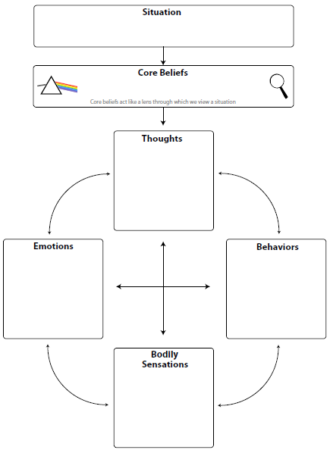By Deborah Etienne-Ward
It is common to assume that our feelings are automatic and that they occur as a direct result of situations and other people. Often we are unaware that our thoughts, feelings, and behaviours are all linked. Each time an event or situation occurs, our brain processes and evaluates the information. When the information is evaluated, automatic thoughts are elicited. The automatic thoughts that we have result from underlying beliefs. Automatic thoughts determine how we feel and influence the way that we behave. This process can be seen in the diagram below:
Source: Psychology Tools
What are automatic thoughts?
Automatic thoughts are usually based on underlying beliefs. Automatic thoughts can be positive, neutral, or negative. It is the negative automatic thoughts that often cause emotional distress. People suffering from an eating disorder often have negative automatic thoughts focused around their shape, weight, and ability to control their eating. Automatic thoughts are not necessarily based in reality and the same situation can elicit different thoughts and subsequently different feelings in different people. For example, imagine sitting at the bus stop and seeing a group of girls walk by and start laughing. A negative evaluation and negative automatic thought of this situation may be “they are laughing at me because they think that I am fat”. However, a neutral evaluation and thought of the same situation may be “they are laughing at a joke”. Whilst the first negative thought may elicit feelings of guilt, shame or sadness, the second thought might elicit a feeling of indifference.
Why do different people evaluate the same situation differently?
We all have different styles of thinking, some of which can be unhelpful. Here are some common unhelpful thinking styles. See if you can identify any that you might use.
- Black and White Thinking: When we see things in extremes such as either “good or bad”, or “right or wrong”. An example of this is “If I have one cookie, I may as well have ten”.
- Mental Filter: Involves only paying attention to certain aspects of a situation, and ignoring the rest. For example, “Everyone thinks I am fat” despite receiving a compliment about how good you look the previous day.
- Jumping to conclusions: We make predictions about what other people are thinking or what will happen in the future. For example, “She is laughing because she thinks I am fat”.
- Catastrophising: This is evident when we make things seem like a much bigger problem than they are in reality. For example, “If I don’t stay thin, nobody will ever find me attractive and I will be alone forever”.
- Shoulding and Musting: Putting unrealistic pressure on ourselves. For example, “I must never eat sugar”.
- Labelling: We label ourselves and other people when we make global statements about certain situations even though there are many more examples that are not consistent with that label. An example of this is “I am weak because I binge eat”.
- Emotional Reasoning: This is when you base your view of yourself on your feelings. E.g. “I feel disgusting so I must have gained weight”.
- Magnification and minimisation: We magnify the good attributes that we see in other people, and minimise the good attributes that we possess. For example, “She said that I am beautiful, but that doesn’t count as she says nice things to everyone”.
What can I do to manage my automatic thoughts and help improve the way I feel?
Here are some things that we can ask ourselves when we notice an unpleasant feeling such as guilt, shame, sadness, or anxiety.
- What event or thought happened before the feeling?
- What thoughts were going through my head?
- Which unhelpful thinking style(s) was I using? Identifying these styles can help to see if you have a certain pattern of thinking styles. For example you may find that you are frequently using ‘Black and White Thinking’.
We can then challenge our unhelpful thinking patterns by being an objective observer and questioning truthfulness of our unhelpful thoughts. This can be done by:
- Distancing yourself from the situation and thinking about what other people might think if they were in the same situation, or if they were watching the situation.
- Weighing up the evidence that the thoughts are true and not true.
After challenging our thoughts we can replace unhelpful thoughts with more helpful ones. For example, let’s use our first example of seeing the girls laughing whilst you are waiting at the bus stop, and having the thought that “the girls were laughing because they think that I am fat”. After identifying the unhelpful thinking style (jumping to conclusions), and challenging the thought (what evidence do I have?), you could replace the unhelpful thought with a more helpful one such as “they are laughing at a joke”. You will notice that when we challenge and replace our unhelpful thoughts, our level of distress decreases.
Contact us at BodyMatters if you would like support to help you to manage unhelpful thoughts and thinking styles.
References
Centre for Clinical Interventions (2008). Retrieved here.

